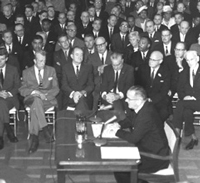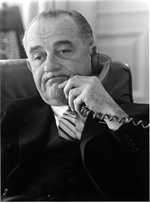How Did The Great Society Program Change The Federal Government
Did the U.s.a. lose the war on poverty?
Digital History TOPIC ID 111
 Lyndon Baines Johnson had a vision for America. During the 1964 Presidential entrada he oftentimes spoke about it. He envisioned an America "where no child will go unfed and no youngster will get unschooled; where every child has a good teacher and every teacher has good pay, and both accept good classrooms; where every homo has dignity and every worker has a job...." Johnson called his vision the Great Society, and he committed his administrating to waging a "war on poverty."
Lyndon Baines Johnson had a vision for America. During the 1964 Presidential entrada he oftentimes spoke about it. He envisioned an America "where no child will go unfed and no youngster will get unschooled; where every child has a good teacher and every teacher has good pay, and both accept good classrooms; where every homo has dignity and every worker has a job...." Johnson called his vision the Great Society, and he committed his administrating to waging a "war on poverty."
To combat poverty, the federal government raised the minimum wage and enacted a battery of programs to railroad train poorer Americans for better jobs. To assure acceptable housing, the authorities attacked urban blight, began a programme of hire subsidies, and set up a cabinet-level Department of Housing and Urban Evolution. To promote education, the federal government set upwardly a arrangement of college loans. To address the nation's health needs, the federal regime enacted Medicaid,to pay for the medical expenses of the poor, and Medicare, extending medical insurance to older Americans under the Social Security System.
When Lyndon Johnson left the presidency in 1969, he left behind the legacy of a transformed federal government. At the end of the Eisenhower presidency in 1961, there were but 45 domestic social programs. By 1969 the number had climbed to 435. Federal social spending, excluding Social Security, rose from $nine.9 billion in 1960 to $25.six billion in 1968. Johnson'due south "state of war on poverty" represented the broadest attack Americans had ever waged on the special bug facing poor and disadvantaged families. It declared decisively that the problems of the poor--problems of housing, income, employment, and health--were ultimately a federal responsibility.
When Johnson announced his Smashing Society program in 1964, he promised to reduce poverty, alleviate hunger and malnutrition, aggrandize community medical care, provide adequate housing, and heighten the employability of the poor. Did he go along his promise?
 When President Johnson came to part 22 percentage of the nation's families lived in poverty (downwards from 30 per centum in 1950). The nation's largest programs to help the poor--Aid to Families with Dependent Children, Social Security, and Nutrient Stamps--provided meager benefits to only a small proportion of the country's impoverished population. AFDC paid but $388 a month (in 1980 dollars) to a family of 4; Social Security payments averaged just $184 a month (in 1980 dollars); and nutrient stamps reached just two percent of the nation's poor. Medicare and medicaid did not exist. Thirty-3 million poor people competed for only 600,000 public housing units.
When President Johnson came to part 22 percentage of the nation's families lived in poverty (downwards from 30 per centum in 1950). The nation's largest programs to help the poor--Aid to Families with Dependent Children, Social Security, and Nutrient Stamps--provided meager benefits to only a small proportion of the country's impoverished population. AFDC paid but $388 a month (in 1980 dollars) to a family of 4; Social Security payments averaged just $184 a month (in 1980 dollars); and nutrient stamps reached just two percent of the nation's poor. Medicare and medicaid did not exist. Thirty-3 million poor people competed for only 600,000 public housing units.
When Johnson left function, the official poverty rate had fallen from 22 percent in 1960 to xiii percent - which is where the poverty rate remains today. AFDC payments had risen to $577 (in 1980 dollars). Baby mortality amidst the poor, which had barely declined betwixt 1950 and 1965, cruel by 1-third in the decade after 1965 as a result of the expansion of federal medical and nutritional programs. Earlier the implementation of Medicaid and Medicare, xx percent of the poor had never been examined by a physician; when Johnson retired equally president the figure had been cutting to 8 pct. The proportion of families living in substandard housing--that is, housing lacking indoor plumbing - also declined steeply, from 20 pct in 1960 to xi percent a decade later.
Despite these gains, Johnson's critics charge that "in the war on poverty, poverty won." Political conservatives argued that public assist, food subsidies, health programs, and child intendance programs weakened poorer families. President Ronald Reagan voiced a common conservative viewpoint when he declared, "There is no question that many well-intentioned Great Order-blazon programs contributed to family unit breakups, welfare dependency, and a big increase in births out of wedlock."
To support their arguments, conservatives cite a close chronological connection between increased regime welfare expenditures and dramatic increases in female-headed households and illegitimacy among the poor. Back in 1959, just ten percent of low-income Americans lived in a single-parent household. By 1980, the figure had climbed to 44 percent. At the same time the number of illegitimate births among the poor grew substantially. Had the number of single-parent families remained at the 1970 level, the number of poor families in 1980 would have been 32 percent lower than it was.
Did the expansion of state services contribute to rising rates of illegitimacy and single parenthood? The answer to this question remains in dispute. On the 1 manus, there is no empirical evidence that there is a correlation between the level of welfare payments the number of children in single parent families. Other studies have shown that increases in the wages of the poor produce a sharp drop in female-headed households - suggesting that it is low wages and unstable jobs, and non the level of welfare payments, that are the major contributors to family instability.
Some of the apparent deterioration in poor families is illusory. If female-headed families made up a growing proportion of the poor, this partly reflected a precipitous reduction in poverty among other groups. 1 of the consequences of the Neat Society was to dramatically change the profile of the poor. Increases in Social Security payments sharply reduced the incidence of poverty among the elderly. The Supplemental Social Security program introduced in 1973 greatly reduced poverty amongst the disabled. As a result of reductions in poverty among the elderly and disabled and increases in the number of single parent, female headed households, poverty has been increasingly feminized.
And yet, if the war on poverty accomplished more than its critics charged, there can exist little doubt that the Johnson assistants failed to persuade Americans that it had been successful. Beginning with the Presidential election of 1988, the Republican party won five of six elections and controlled the White Business firm for xvi of xx years. Why?
A 1969 book entitled The Emerging Republican Majority by political commentator Kevin Phillips offered an answer. He claimed that the Corking Society provoked an angry reaction among big segments of the white working class and eye class. Issues of race - such as affirmative activity, schoolhouse busing, residential integration, and racial preferences in job option and government contracting - along with a reaction against the antiwar movement, cultural permissiveness, crime, cutbacks in local control of schools and neighborhoods, and liberal Supreme Courtroom decisions on subjects ranging from pornography to the rights of criminal defendants, Phillips argued, had fractured the political coalition that had arisen during the Great Depression of the 1930s.
Questions to call up virtually:
i. Divorce rates, illegitimacy rates, and single parenthood increased not only among the poor but among the center form as well. How would you account for these changes in family patterns?
2. Certain structural changes in the American economy take contributed to high unemployment rates in primal city areas. Place these structural changes.
3. Why, in your view, has the poverty rate remained roughly constant since 1969?
Copyright Digital History 2021
Source: https://www.digitalhistory.uh.edu/topic_display.cfm?tcid=111
Posted by: pylantantless.blogspot.com

0 Response to "How Did The Great Society Program Change The Federal Government"
Post a Comment